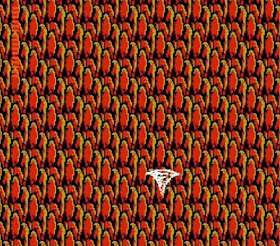
Before I begin drawing somewhat absurd comparisons, I'd like to offer some sincere words of praise. THE THIEF OF BAGDAD is truly something special, a magical fusion of the irrepressible star quality of Douglas Fairbanks, William Cameron Menzies' spectacular art direction, imaginative staging, and innovative special effects– it's truly the perfect blend of adventure-fantasy-comedy-romance, and its shadow lays heavy across the canon, from THE ADVENTURES OF ROBIN HOOD to JASON AND THE ARGONAUTS to BIG TROUBLE IN LITTLE CHINA, to the STAR WARS, INDIANA JONES, and LORD OF THE RINGS trilogies. I could go on. But I, devoted to bizarre 80s pop culture minutiae, shall now draw parallels (with increasing specificity) between THE THIEF OF BAGDAD and classic Nintendo games (specifically SUPER MARIO BROTHERS and the CASTLEVANIA series), whose makers were likely inspired by this classic of silent cinema.
The General:
It might seem fairly broad to draw a parallel between Douglas Fairbanks sliding down a magic, freestanding rope


and a similar action in SUPER MARIO BROTHERS,

but then there's his propensity for popping in and out of pipe-shaped wells,


his battles with dragon-like foes,


and his skillful dodging of fireballs by timing his jumps through a now-stereotypical "Cave of Danger"


which easily compares to a similar trope seen in nearly every sidescroller.


Pictured here from CASTLEVANIA I.
These are all fairly commonplace ideas, and not necessarily tied to THE THIEF OF BAGDAD, though the film's latter "quest" half is neatly divided into levels with "bosses" at the end of each scene, with creepy enchanted forests and spider-monsters



killer man-sized bats,


and dangerous spiked gates.


The Specific:
I first thought of CASTLEVANIA (and the ZELDA series, too) when Fairbanks encounters a old man who offers obscure puzzle-solving advice,


which later became a cliché in Nintendo adventure gaming:


CASTLEVANIA I.


CASTLEVANIA II.
But then I began to think about the day/night transitions. THE THIEF OF BAGDAD has a greater magnitude of these than most comparable silent films. The transitions become a plot point, too, as the Princess summons her suitors to bring her the world's most magical treasures within "seven moons."

And after each moon, we're privy to a transition:



This continues throughout:

et cetera,

et cetera...

While these title cards are not narratively bothersome in THE THIEF OF BAGDAD, it is my belief that the makers of CASTLEVANIA II, in attempting to pay homage, inadvertently peppered their game with this kind of action-pausing distraction:


Finally, for those not yet convinced, I present the coup de grace. In THE THIEF OF BAGDAD, Douglas Fairbanks acquires a "Cloak of Invisibility." When he wears it, he is transformed into a mostly-invisible energy tornado, and speeds along on his merry way.



Now, compare this to the aforementioned cryptic "traveling tornado" in CASTLEVANIA II:

Simon kneels in the cemetery with the crystal,


becomes invisible,

I'm certain that this exercise has been incredibly enlightening to the two or three of you out there who are scholars of both silent film and NES gaming.

I'm a scholar of neither silent film nor NES games, but I'll be damned if this wasn't a spot on comparison. I'm sold. But, unfortunately, it comes in a close second in my list of greatest "Only Now Does It Occur To Me..." series favorites, followed by the amazingly poignant Crocodile Dundee/Pretty Woman smasher.
ReplyDeleteGreat stuff!
I didn't even know I *was* a scholar of silent film and NES gaming until I read this.
ReplyDeleteThat in itself makes it worthwhile.
Big, big fan of the site.
Ben,
ReplyDeleteVery glad you enjoyed; obviously I'm a big fan of the oddball, incredibly specific comparison.
John,
Glad you dug it– Nice to meet a fellow scholar!